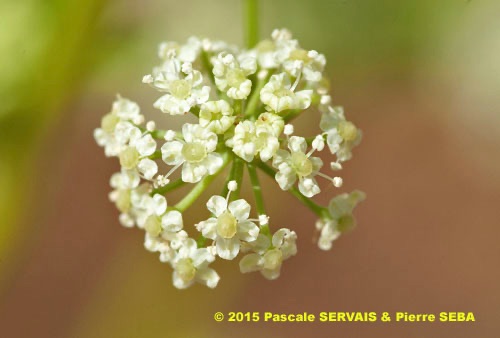
Apium graveolens L.
Fam. : Apiaceae
© Pascale SERVAIS & Pierre SEBA, 2018. Tilo Botanica: Flore de Tilos et du Dodécanèse / Flora of Tilos and of the Dodecanese
English translation by Brenda Bradbury, Howard Bradbury and Stéphane Léonard
Plante herbacée, hermaphrodite, à forte odeur de céleri, à tiges robustes, érigées, glabres, ramifiées, vertes, cylindriques, cannelées, creuses, de 6 à 15 mm de diamètre.
Feuilles à la base et alternes, composées pennées ou bipennées, luisantes, vertes, pétiolées, de 6 à 30 cm de long, de 4 à 10 cm de large, glabres, avec des segments losangiques à lancéolés, dentés et lobés. Feuilles supérieures à 3 segments plus étroits, à gaine bordée de blanc.
Fleurs à symétrie radiaire, blanches, de 1 à 2 mm de diamètre, groupées en ombelles composées de 1 à 6 cm de diamètre. Ombelles principales à 4 à 12 rayons inégaux, sans involucre mais avec 1 feuille trifoliée à leur base. Corolle à 5 pétales égaux, libres, suborbiculaires, en cœur, entiers, terminés par une pointe enroulée. Calice à 5 sépales soudés, à limbe nul. 5 étamines à filet blanc et à anthère blanche. Ovaire infère.
Fruits, akènes ovoïdes à subglobuleux, de 1 à 2,5 mm de long, brunâtres, glabres.
___________________________
Plant herbaceous, hermaphrodite, with strong celery smell. Stems robust, erect, glabrous, branched, green, cylindrical, grooved, hollow, from 6 to 15 mm in diameter.
Leaves at the base and alternate, compound pinnate or bipinnately, shiny, green, petiolate, from 6 to 30 cm long, from 4 to 10 cm across, glabrous, with diamond-shaped to lanceolate segments, toothed and lobed. Higher leaves with 3 narrower segments, with sheath fringed with white.
Flowers radially symmetrical, white, from 1 to 2 mm in diameter, joined together in compound umbels from 1 to 6 cm in diameter. Main umbels with 4 to 12 unequal rays, without involucre but with 1 trifoliate leaf at their base. Corolla with 5 equal, free, suborbicular, heart-shaped, entire petals, finished by a coiled point. Calyx with 5 fused sepals, without blade. 5 stamens with white filament and white anther. Ovary inferior.
Fruits, ovoid to subglobose achenes, from 1 to 2.5 mm long, brownish, glabrous.
Descripteurs / Identifying features
1
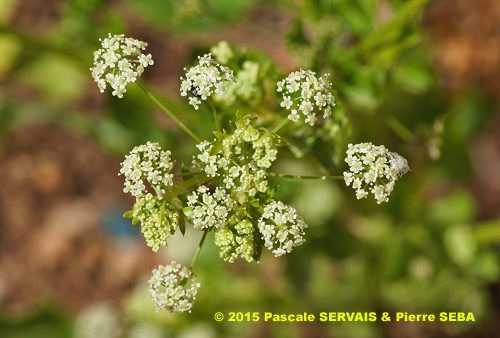
2
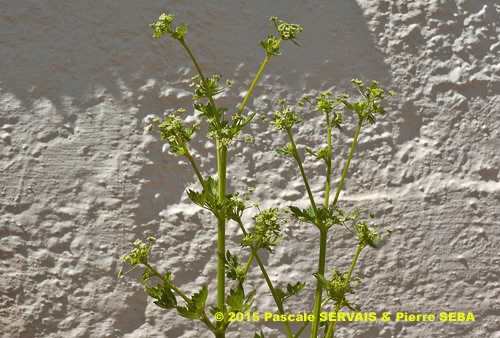
3
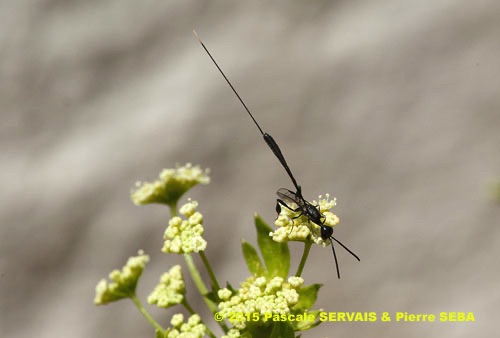
4
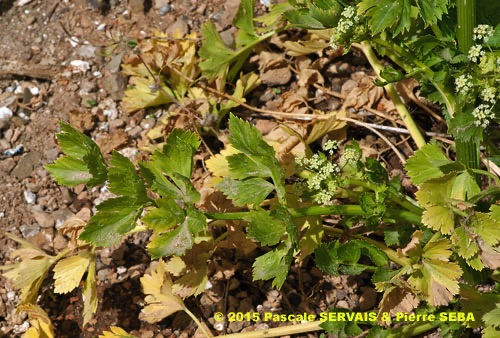
5
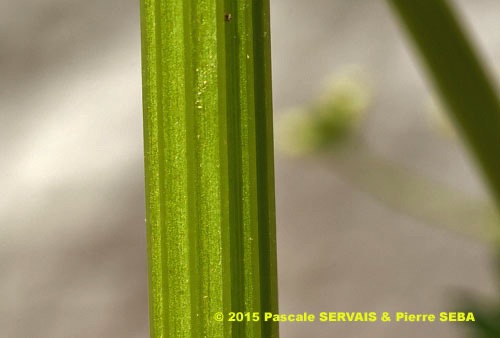
6
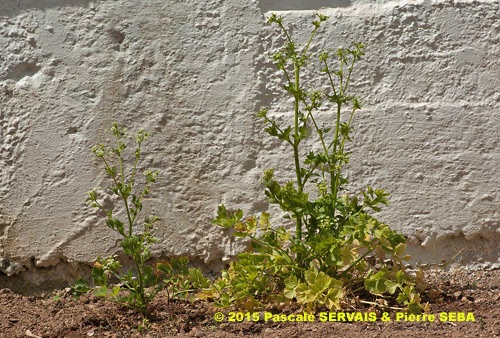
7
Étymologie / Etymology :
Apium : emprunt du latin apium, -ii (nom) = le céleri, le persil,
nom donné à la plante par Pline, naturaliste latin mort en 79 apr. J.-C.
Graveolens : emprunt du latin graveolens (adj.) [ < gravis, -is, -e (adj.)
= lourd, fort, pénétrant + oleo, -es, -ere (verbe) = avoir une odeur,
sentir ] = qui sent fort, fétide.
Apium : borrowed from Latin apium, -ii (noun) = celery, parsley,
name given to the plant by Plinius, Latin naturalist died in 79 AD.
Graveolens : borrowed from Latin graveolens (adj) [ < gravis, -is, -e (adj)
= heavy, strong, pervasive + oleo, -es, -ere (verb) = to be odorous,
to smell ] = strong smelling, fetid.
Synonymes / Synonyms :
Apium celleri Gaertn.
Apium decumbens Eckl. & Zeyh.
Apium lusitanicum Mill.
Apium maritimum Salisb.
Apium palustre Thore
Apium vulgare Bubani
Helosciadium ruta DC.
Helosciadium rutaceum St.-Lag.
Seseli graveolens (L.) Scop.
Sison ruta Burm.f.
Sium apium Roth
Sium graveolens (L.) Vest
Smyrnium laterale Thunb.
Noms vernaculaires / Common names :
Noms français / French names :
Ache — Ache odorante — Ache puante — Céleri — Cèleri —
Céleri odorant — Céleri rave.
Noms grecs / Greek names :
Αγριοσέλινο — Άπιο το βαρύοσμο — Σέλινο.
Noms anglais / English names :
Smallage — Wild celery.
Noms allemands / German names :
Echter Sellerie — Eppich — Knollensellerie — Wilder Sellerie.
Noms espagnols / Spanish names :
Apio — Apio silvestre — Apirrábano.
Noms italiens / Italian names :
Sedano — Sedano comune.
Habitat :
Cultures - Jardins - Prairies - Lieux humides, mares -
Lieux saumâtres, bords de mer - Sols sableux.
Cultivated places - Gardens - Meadows - Damp places, ponds -
Salty places, seaside - Sandy soils.
Île / Island :
Tilos.
Hauteur / Height range :
De 30 cm à 1 m.
From 30 cm to 1 m.
Floraison / Flowering time :
De mai à juillet.
From May to July.
Groupe / Classification :
Dicotylédones.
Dicotyledons.
Pérennité / Lifespan :
Bisannuelle.
Biennial.
Description :
Photo 1 :
Localisation / Location : Tilos, Livadia, Village
Date : 20/05/2015
GPS : Lat. 36,41214° N / Long. 27,38805° E / Alt. 3 m
Type : Photographie numérique / Digital Photograph (10 mégapixels)
Photo 2 :
Localisation / Location : Tilos, Livadia, Village
Date : 20/05/2015
GPS : Lat. 36,41214° N / Long. 27,38805° E / Alt. 3 m
Type : Photographie numérique / Digital Photograph (10 mégapixels)
Photo 3 :
Localisation / Location : Tilos, Livadia, Village
Date : 20/05/2015
GPS : Lat. 36,41214° N / Long. 27,38805° E / Alt. 3 m
Type : Photographie numérique / Digital Photograph (10 mégapixels)
Photo 4 :
Localisation / Location : Tilos, Livadia, Village
Date : 20/05/2015
GPS : Lat. 36,41214° N / Long. 27,38805° E / Alt. 3 m
Type : Photographie numérique / Digital Photograph (10 mégapixels)
Photo 5 :
Localisation / Location : Tilos, Livadia, Village
Date : 20/05/2015
GPS : Lat. 36,41214° N / Long. 27,38805° E / Alt. 3 m
Type : Photographie numérique / Digital Photograph (10 mégapixels)
Photo 6 :
Localisation / Location : Tilos, Livadia, Village
Date : 20/05/2015
GPS : Lat. 36,41214° N / Long. 27,38805° E / Alt. 3 m
Type : Photographie numérique / Digital Photograph (10 mégapixels)
Photo 7 :
Localisation / Location : Tilos, Livadia, Village
Date : 20/05/2015
GPS : Lat. 36,41214° N / Long. 27,38805° E / Alt. 3 m
Type : Photographie numérique / Digital Photograph (10 mégapixels)

Google Maps
Google Maps
Google Maps
Google Maps
Google Maps
Google Maps
Google Maps